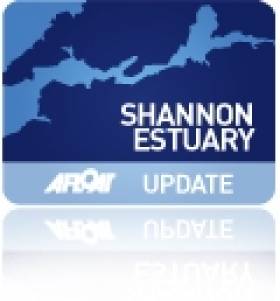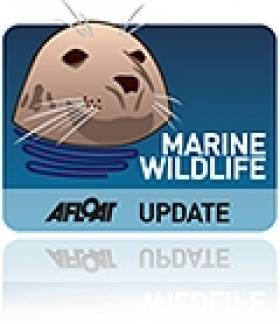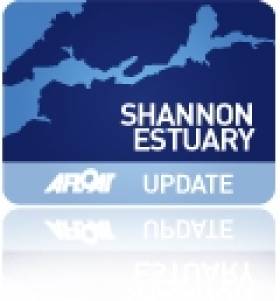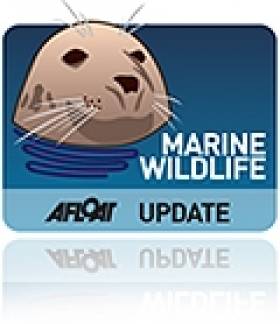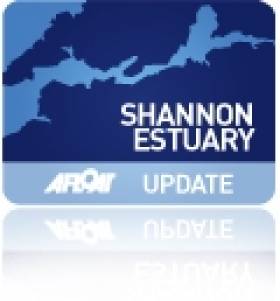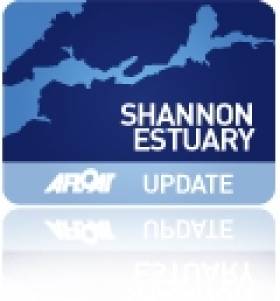Displaying items by tag: Shannon Estuary
#MarineWildlife - The Irish Whale and Dolphin Group (IWDG) is marking 20 years of researching the dolphins of the Shannon Estuary.
As the IWDG's Dr Simon Berrow relates, it was not an auspicious start on 2 May 1993 when the first research trip on the estuary returned after five hours without having seen a single cetacean.
But the following day brought a bounty, with 16 dolphins across three different groups located by the IWDG - the beginning of two decades of sightings and recordings for the Shannon Dolphin Project, which has identified around 230 individual dolphins to date.
Thanks to that project, we know today that at least six of those dolphins first seen in 1993 are still in the estuary as of last year.
The Shannon Dolphin Project now has a website explaining its achievements and the work of the Shannon Dolphin and Wildlife Foundation (SDWF) over the years.
Meanwhile, Afloat reader Karl Grabe has also produced a spectrogram and edit of hydrophone recordings captured by Dr Berrow of Shannon dolphins just a few weeks ago.
Grabe previously uploaded a wonderful snippet of dolphins vocalising in the estuary late last year.
#ShannonEXERCISE- A two-day exercise held on the Shannon Estuary last week was a first in Europe, in that it involved testing Smartly Remotely Operated Submarines and Unmanned Aerial Vehicles.
The exercise replicating the scenario of a 43,000 tonne container ship 'Marée Noire' suffering hull damage when impacting with rock entering the Shannon Estuary due to loss of steering and floundering off the coast of Scattery Island.
The estuary off Co. Clare has become a key European test site for a range of highly advanced 'smart technologies' Marine Robots and Unmanned Aerial Vehicles.
The University of Limerick is leading the integration and deployment of the underwater and aerial technologies, within this exercise as part of a European Research Collaboration NETMAR which has Irish, UK, French, Spanish and Portuguese partners.
The exercise is a first in terms of scale and use of robotic platforms as part of Ireland's largest marine emergency response exercise to deal with a major environmental disaster.
Bunratty Dolphins Move On To Deeper Waters
#MarineWildlife - The trio of bottlenose dolphins who took up residence close to Bunratty Castle recently have apparently moved back out to deeper water after growing concerns for their well-being.
As previously reported on Afloat.ie, the dolphins had made their home opposite Durty Nellys pub in the Ratty River, which flows into the Shannon Estuary.
Simon Berrow of the Irish Whale and Dolphin Group (IWDG) explained that it's not unusual for dolphins to forage for food in waterways that feed into the estuary, though they usually return to the main catchment on their own shortly after.
With fears that their acoustic abilities were impaired, preventing them from navigating downstream past a series of bridges and concrete pillars between them and the main watercourse, a rescue attempt had been planned for late last week.
But as the Clare People reports, this was called off as the dolphins were spotted less and less frequently in the area.
Later hydrophone tracking by the IWDG led experts to discover that the cetaceans were able to come and go as they pleased.
Despite this, dolphins only have a limited ability to survive in fresh water, and can develop serious kidney and skin problems if exposed for a significant length of time.
Harbour Funding Approved for Ballyvaughan, Cappagh, Liscannor, Carrigaholt & Kilbaha
#clare – Minister for Agriculture, Food and the Marine, Simon Coveney, T.D., today announced funds totalling 91,500 euro for projects at Ballyvaughan, Cappagh, Liscannor, Carrigaholt and Kilbaha harbours/piers.
"The safety works scheduled to take place at these harbours will have a hugely positive impact on the livelihoods of fishermen and other users of the piers," explained Clare Senator Tony Mulcahy. He added: "These projects are central to ensuring the safety of all users of the piers. The continued upgrading of these piers is essential to the development of both industry and tourism in the respective areas."
The funding announcement features allocations of €22,500 to Carrigaholt, €37,500 to Ballyvaughan, €9,000 to Kilbaha, and €11,250 to both Liscannor and Cappagh.
According to Senator Mulcahy: "The funding contribution from the Government covers 75% of the total cost of the relevant projects which include repairs to the pier wall in Ballyvaughan, the installation of a handrail to pier access, harbour wall and upgrade of visitor moorings at Carrigaholt, a complete remediation to the existing pier walls at Liscannor, repairs to the sea wall at Cappagh, and repairs to the harbour wall capping stones at Kilbaha."
Dolphin Trio At Home Near Famous Watering Hole
#MarineWildlife - Three bottlenose dolphins have made a new home close to a famous tourist watering hole in Co Clare.
According to the Irish Independent, the trio have taken up residence next to Durty Nellys pub in the Ratty River, which flows past Bunratty Castle into the Shannon Estuary.
The Irish Whale and Dolphin Group (IWDG), which has been tracking the group, believes they originated from a larger group populating the estuary.
As the IWDG's Simon Berrow explains, such dolphins are known to forage for food in rivers that feed into the estuary, and will return to the main catchment on their own.
While the risk of stranding in the shallower waters of rivers is unlikely, there is growing concern that the dolphins have been in the area for longer than expected.
"We can't rule out the possibility that their acoustic abilities may be impaired by the series of bridges and concrete pillars that span one of the bridges, and that they may be finding it difficult to navigate as a result of an 'acoustic trap'," says Berrow.
The IWDG says it is in discussion with the National Parks and Wildlife Service as to what options are available to step in to shepherd the trio back to the Shannon Estuary if necessary.
#sailforcancer – Two Foynes Yacht Club (FYC) Sailors on the Shannon Estuary, Chris Egan and Dave Bevin, will sail around Ireland this summer to raise funds for the Irish Cancer Society.
Both men are facing their own personal Cancer challenges and are determined to do something positive to support the amazing work currently being done by the Cancer Society in Ireland.
Over the summer months, the voyage around Ireland will cover up to 1200 nautical miles and the sailors will be visiting over thirty coastal safe havens, keeping the average distance per day sailed to around 40 nautical miles.
The Royal National Lifeboat Institution are collaborating closely on the planning of the trip the yacht "Inizi" is a 30ft Jeanneau Rush and is currently on the hard stand at FYC and being prepared for the trip.
The yacht will undergo a full RNLI Sea Safety Check before launch. The two intrepid voyagers are experienced coastal and offshore sailors and a third crew spot will be filled in rotation by the members of Foynes Yacht Club as the journey progresses.
A promotion and fundraising organisation will be in place to support the crew of Inizi and will be coordinated by Foynes Yacht Club, the Irish Cancer Society and the RNLI.
This website will be the key hub for all fundraising and communication.
The sailors will publish on the webpage a Cruising Log of each leg. This will give an entertaining and detailed account of the journey and will be of interest to anybody who might take such a trip in the future or indeed to anybody who might simply like to enjoy reading about the experiences of a crew of small boat sailors making their way around the amazing Irish Coast.
Email: [email protected]. Mobile 087 2264661
Accidental Pollution Leads To Fish Kill In Co Kerry
#FishKill - Accidental pollution from a farm in Co Kerry has resulted in a fish kill on a tributary of the Ballyline River.
Inland Fisheries Ireland were contacted by Kerry County Council on Saturday 16 March after being altered by a farmer to a slurry spill on his property in the Kilgarvan area of Ballylongford.
Upon arriving at the farm, IFI officers found one side of the slurry pit wall had collapsed, resulting in a large slurry spill. Two cattle were also injured in the incident and had to be put down.
The slurry went into a watercourse that eventually flows into the Shannon Estuary at Ballylongford Bay.
The farmer had carried out emergency measures on site attempting to contain the slurry and also trying to minimise the impact to fish and wildlife downstream.
Fisheries officers carried out a visual inspection downstream but as the slurry was still passing there was strong discolouration and so it was impossible to see any dead fish. Samples were taken and sent for analysis immediately.
The situation was monitored over the weekend, and a full walkover of the stream was carried out as the water cleared on Tuesday 19 March.
IFI can confirm that a fish kill took place as a result of the pollution incident, and that 150 brown trout, hundreds of stickleback, one eel and one flounder were recovered. The section of river downstream from the farm to Gortanacooka Bridge was the most heavily impacted.
Currently there is a buildup of organic sediment in the river from the farm to the first bridge in Graffa Bog, which IFI says will not disperse until there is a flood in the river.
The farm was also inspected on the evening of 19 March and the water within the watercourse was clear. The investigation continues.
#NewMaritimeMuseum – As previously reported, Shannon Foynes Port Company's master plan 'Vision 2041' looks forward to the future and soon the past will be explored when a new maritime museum opens next month, writes Jehan Ashmore.
It was at the launch of the masterplan at the Foynes Flying Boat Maritime Museum, where the new museum (opening 14 March) will be incorporated, to trace the rich history of the Shannon Estuary.
As the largest 'navigable' estuary (500km2) in Ireland and one of the deepest waterways in Europe, the museum will not just focus on shipping, but also the geology, personality and mythology of the estuary stretching from Limerick Docks down to Loop Head, marking the mouth of Shannon.
As previously reported, vessels such as the 82,562dwt London 2012, a dry bulk-carrier (Length: 229m X Beam: 32m X Draft: 14m) had docked at the Aughinish Alumina jetty last month.The port, which is Ireland largest bulk port company can handle larger vessels up to 200,000dwt, however under Vision 2041, the Shannon estuary is to cater for the World's largest container ships as the port is strategically located as a potential hub-port in Western Europe and creation of a 'Ocean Energy Hub'.
Its prime position is to take advantage of the new 'post-Panamax' sized super container ships and tankers under construction following the completion of the enlarged Central American canal linking the huge Asian market, notably from China and or via North America and onwards to Europe.
As these developments look to the future prospects of the estuary's ports, the past will not be forgotten as the flying boat museum with its replica aircraft based in Foynes, will have a new floor dedicated to exhibits. The diversity of topics on display in the maritime museum are listed below.
• The charts and maps of the river from the time of Ptolemy.
• The geology, tides and weather of the Shannon
• The pilots who raced in their rowing boats to be the first to guide large sailing ships up the estuary
• The dockworkers loading and unloading a vast range of cargo from ocean-going ships
• The "Spring-Rice Set" —the O'Briens, De Veres and Spring Rices, who owned large tracts of land on the shores of the river but who were actively concerned in the welfare of the less fortunate people around them
• The amazing record of ships on the river left to us by Murrogh O'Brien in the form of paintings and charts
• Different types of ships and boats used on the river
• The development of Foynes Port
• Navigation of the river including the many lighthouses that guided mariners up the river
• The tragic story of the Colleen Bawn
• The story of Transportation and emigration on the river.
• Tait's manufacture and export of uniforms to the American confederates during the Civil War.
• Display with Met Maps and audio visual on weather conditions.
• Story of the Windsor Castle Ghost Ship, sailed up the Shannon in 1843.
• Audio Visual on life on the River Shannon.
The maritime museum will be opened to the public from 14 March, 9am-5pm (visitors should try and arrive an hour before closing). For further details visit: www.flyingboatmuseum.com/
Master Plan for Shannon Estuary Launched
#Shannon - The Shannon Foynes Port Company has launched its master plan for the development of port infrastructure and services along the Shannon Estuary.
RTÉ News reports on the 30-year plan, titled Vision 2041, which will involve the construction of a new deepwater birth at Foynes, the development of warehousing and facilities across 300 acres of additional land - and the potential reopening of the Foynes-Limerick railway line, which has lain dormant since 2001.
As one of the deepest waterways in Europe, the estuary is also in prime position to take advantage of the new 'post-panamax' supertanker shipping era, and talks on securing future foreign direct investment as a priority.
As previously reported on Afloat.ie, submissions for the accompanying strategic plan for the development and management of marine-related industry and tourism in the Shannon Estuary region closed last week.
The Draft Strategic Integrated Framework Plan (SIFP) for the Shannon Estuary, the first of its type to be developed in Ireland, identifies a number of strategic sites along the estuary for future possible development in the areas of industry, tourism, energy, fishing and aquaculture and marine-related industry.
Time Called for Submissions to Shannon Estuary Plan
The agencies behind a major strategic plan for the future development and management of marine-related industry and tourism along the Shannon Estuary have advised that the closing date for submissions is this Friday (February 15th 2013).
#shannoestuary – The Draft Strategic Integrated Framework Plan (SIFP) for the Shannon Estuary has been commissioned by a multi-agency steering group comprising Clare County Council as lead authority, Kerry County Council, Limerick City and County Councils, Shannon Development and Shannon Foynes Port Company.
The land and marine-based plan, the first of its type to be developed in Ireland, indentifies a number of strategic sites along the Estuary for future possible development in the areas of industry, tourism, energy, fishing and aquaculture and marine-related industry.
A series of public consultations on the SIFP for the Shannon Estuary took place in Clare, Kerry and Limerick in late January. The Plan will remain on display until this Friday to give the public an opportunity to view the proposals and put forward their opinions to the appointed project consultants, RPS Consulting Engineers.
To coincide with the public consultation process an amateur photography competition is being held, the closing date for which has been extended to Friday, February 22nd, 2013. With two categories, 'Adult' and 'U18', photographs submitted can feature any aspect of the Estuary, including people, places, biodiversity, work and recreation activities.
On completion in late 2013, it is anticipated that the SIFP will be incorporated, by means of Variation, into the relevant County and City Development Plans in Clare, Limerick and Kerry. Further consultation with the public will take place as part of that statutory Variation process.




























